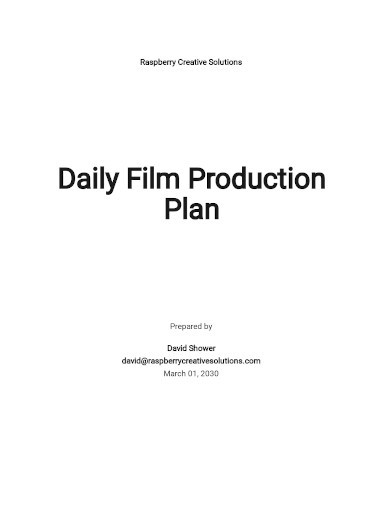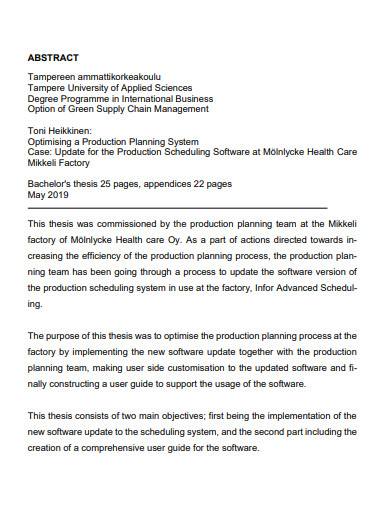When companies produce products to sell or provide services to customers as part of their ways to earn big profits, a production plan is essential for them to have as this is the best way to guarantee them to produce high-quality products as efficiently as possible. These companies hire people who are responsible to screen the production planning and familiarize themselves with the inner workings, monitor resources, collaborating with people working in the production, and know the products or services they produce. If you’re one of those people in charge of production planning, one of those tasks includes planning for daily production to be as efficient as possible. Read the article to know how to make a daily production plan.
3+ Daily Production Plan Samples
1. Daily Production Plan

2. Daily Food Production Plan
3. Daily Production Plan Example
What is a Production Plan?
A production plan is a document where it outlines the planning process of the production and manufacturing procedures in a company. It utilizes the allocation of its resources such as its employees, equipment, tools, and materials they use to produce a product, to identify the production capacity of the manufacturer, and to figure out how to cater to different customers.
How to Create a Production Plan?
1. Estimate the Product Demand
Before you delve into planning for your production method, it’s best to study the demand for the product to know which planning method is best for your company to follow. You will also be able to estimate what type of resources are required for the production and how they will be used during the production process.
2. Do an Inventory Plan
Access your inventory and make a list of all the stocks you currently have. Make a management plan so you can use everything efficiently and ensure that nothing goes to waste or you will not experience any shortages.
3. Take Note of the Employees and Equipment Used in the Production
Aside from managing your inventory, familiarize yourself with the day-to-day operations of your company’s production process. Note the number of people who are needed and assigned to create a product or do service. Take note and familiarize yourself with the types of machines and equipment used for daily production and what type of systems are used for these machines and the procedures to operate them safely. These details are important to include in your production plan.
4. Monitor Your Daily Production
Monitoring your production is essential to include in the production planning. Monitor the daily results of the daily production. Compare these results to the projections you came up with and see how the actual results contrast to your projections. This should be done regularly and documented well in your plan.
5. Adjust the Production Plan For a More Efficient Production
The last section to include in the production plan is your reflection on the numerous information you gained from the previous steps you did. From your reflection, you can then make your strategy on what can be done to improve your production planning to go more smoothly and efficiently in the future.
FAQs
What are some common mistakes that occur in production planning?
The below are some situations that mistakes may occur in production planning:
- Not preparing for unexpected events. It’s better to have a plan b when things go awry rather than to scramble and panic on what to do when mistakes happen. Try to think of different scenarios that could happen during the production process and then come up with a plan to figure out what to do in addressing those situations.
- Relying heavily on computers. Even though technology nowadays is getting smarter, it’s best to oversee the resources and the operations in person and in real-time. Collaborate with the people in the production process. Sometimes, computers are not reliable and it’s important to get the best information yourself.
- Neglecting the equipment. Frequent use of equipment could lead to its wear and tear and so it’s important to track its usage and keep up with the regular maintenance to avoid slowing down production.
What are the different types of production planning?
The different types of production planning are job-based planning, batch method, flow method, mass production method, and process manufacturing method.
What are the seven factors of production?
The seven factors of production are land, labor, factory, building, machinery tools, raw materials, and enterprise.
Writing a production plan is meticulous work that you need to commit some time to observe and do your research before you get to complete it. It serves as a guide map on how to do your production processes and procedures well and efficiently that increases your production work, create quality products, and lessen the downtime of the production due to faulty planning. So take your time in creating the plan. When you get to the writing part, make sure that your plan is written clearly and concisely, and should be free from errors. To help you get started on making a cafeteria business proposal, download our free sample templates provided above!
Related Posts
FREE 11+ Snack Schedule Samples & Templates in PDF
FREE 11+ Employee Work Plan Templates in PDF MS Word
FREE 26+ Sample Daily Reports in Google Docs MS Word | Pages ...
FREE 23+ Time Log Samples & Templates in PDF MS Word
FREE 9+ Sample Quality Reports in PDF
FREE 17+ Sample Cleaning Schedules in PDF
FREE 8+ Daily Audit Report Samples & Templates in PDF MS Word
FREE 13+ Quality Assurance Plan Templates in PDF MS Word ...
FREE 33+ Action Plan Samples in PDF
FREE 7+ Weekend Scheduled Samples in Google Docs MS Word ...
FREE 9+ Sample Manufacturing Project Reports in PDF MS Word ...
FREE 9+ Event Operational Plans PDF
FREE 10+ Weekly Schedule for Student Samples [ College, Medical ...
FREE 9+ Kid's Chore Schedule Templates in PDF MS Word
FREE 15+ Restaurant Schedule Templates in PDF MS Word | Excel


